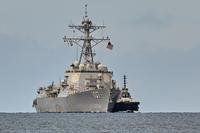Construction of a new heavy-duty icebreaker for the Coast Guard may begin by the end of December, more than five years after the service awarded a contract for the much-anticipated ship's design and build.
Vice Adm. Paul Thomas, the Coast Guard's deputy commandant for mission support, told a House subcommittee Wednesday that the design for the polar security cutter likely won't be complete, but the process will be far enough along to start building portions, or modules, of the vessel.
"We have seen an increase in design maturity that leads us to be optimistic about being able to authorize the start of construction by the end of this year," Thomas said.
Read Next: 5.5% vs. 19.5% Pay Raise: Senate Diverges from House on How Much to Boost Junior Enlisted Paychecks
Thomas didn't have an estimate for when the ship, the future Polar Sentinel, would be delivered, but said the Coast Guard is looking to renegotiate portions of its contract with Mississippi-based Bollinger Shipyards, which bought the company awarded the original contract, VT Halter Marine Inc., in 2022.
"We are in the process of getting much greater clarity in terms of cost and schedule," Thomas told members of the House Homeland Security Committee's Coast Guard and maritime transportation subcommittee.
Last year, Bollinger started construction on a prototype module for the vessel that, if approved, will be integrated into the ship.
The service awarded a $745 million contract in 2019 for the polar security cutter with hopes that the first ship of the class would be delivered in 2023. The ambitious timeline was derailed by the complexity of the design -- U.S. shipbuilders haven't constructed an icebreaker for decades -- as well as rising costs and the shipyard sale.
As construction has stalled, the need for vessels that can handle the rough, but increasingly busy, polar environment has increased. Alaska's sole House member Rep. Mary Sattler Peltola, a Democrat, noted that foreign adversaries have practiced war games off the shores of Alaska and the need for search and rescue and maritime enforcement in the region is great.
"You are our presence," Peltola said during the hearing. "As Alaskans, we are very dependent on you. Our fishing industries are dependent on you, our tourists are very dependent on you."
As an interim measure, the Coast Guard was given $125 million earlier this year to purchase a commercial icebreaker, which it plans to convert to military use. It has not made the buy, however, and is still drafting a request for proposal while also waiting for additional money to operate the ship, according to Thomas.
"Critical -- we asked for about $20 million ... so we could operate and outfit that vessel in fiscal 2024 -- and that was reduced to $1 million. We are going to need additional appropriations in 2025 so we can operate what we buy," Thomas said.
The Coast Guard has called the polar security cutter its top acquisition initiative. With Russia having a large presence in the Arctic and China increasing its visits, as well as growing interest in polar regions for their commercial potential, the U.S. has a strategic interest in maintaining an ongoing presence in the polar areas.
Coast Guard Commandant Adm. Linda Fagan said last year that the service will need eight to nine icebreakers in the coming decades but operates just two ocean-going ships: the Polar Star, a 48-year-old heavy icebreaker capable of slicing through thick Antarctic pack ice, and the Healy, a 26-year-old medium icebreaker used for Arctic operations and research.
During the hearing, which focused on the Coast Guard's decades-long efforts to recapitalize its aging fleet of ships and aircraft and address its shore facility maintenance backlog, an official with the Government Accountability Office said the service lacks a long-term planning vision, leaving it vulnerable to making trade-offs after executing short-term budget decisions.
According to the GAO, the Coast Guard's planned investment portfolio of major acquisition programs has increased by $8.2 billion since 2018, including the polar security program, which has grown to $13.3 billion from $9.8 billion five years ago.
"My testimony today should not be a shock to anyone. The Coast Guard's acquisition portfolio is unaffordable, given historic and predicted budgetary levels. We have consistently been reporting this for over 10 years. The commandant recently testified that, while the Coast Guard requires $1.6 billion to recapitalize assets, up to $4 billion is what is actually required," said Shelby Oakley, the GAO's director for contracting and national security acquisitions.
In her annual state of the Coast Guard speeches over the past couple years, Fagan has said the service needs to be a $20 billion armed force; the Coast Guard's fiscal 2025 budget request was for $13.8 billion.
Oakley said that, in addition to the Coast Guard, the Department of Homeland Security, congressional lawmakers and the Office of Management and Budget have all played a role in the service's historic funding shortfalls.
"The Coast Guard needs to better articulate the full scope of its funding needs," Oakley said. "The Coast Guard and [the Department of Homeland Security] have consistently kicked the can down the road and have not taken steps to realistically lay out a plan for meeting mission needs outside the constrained budget process."












